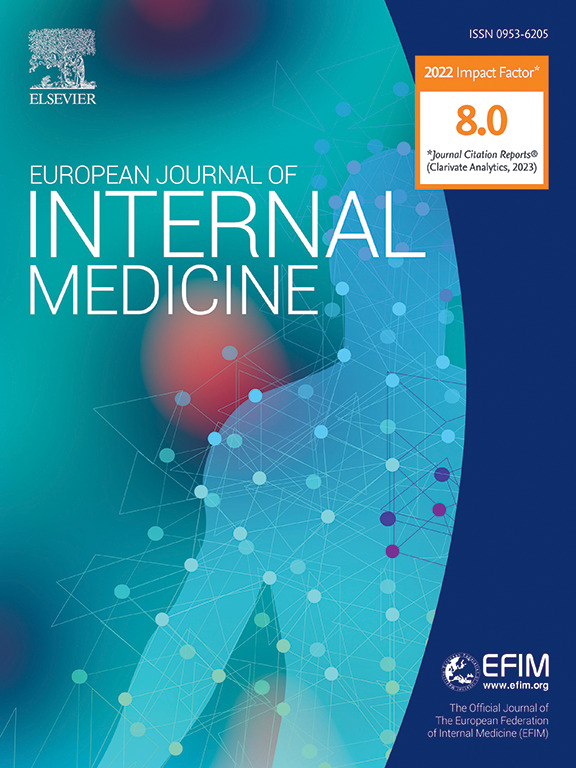Clinically relevant bleeding according to location of metastases in cancer-associated thrombosis
IF 5.9
2区 医学
Q1 MEDICINE, GENERAL & INTERNAL
引用次数: 0
Abstract
Background
Patients with cancer-associated thrombosis (CAT) face a heightened risk of clinically relevant bleeding (CRB). However, the relationship between these risks and the location of metastasis remains unclear.
Methods
A single-center, non-interventional study of consecutive patients was conducted between 2007 and 2022, involving patients with CAT (n = 1,277). Our primary objectives were: 1) To estimate the rate of CRB based on metastasis location. 2) To assess the long-term risk of CRB.
Results
Over a median follow-up of 14.2 months, 144 CRB were observed. The most frequent cancers were colon (19.2 %), lung (16.1 %), and breast (12.4 %). Fifty-two per-cent had metastases. Compared to patients without metastases, metastasis locations associated with CRB were lung metastases (rate 10.0 per 100 patients/year; 95 % confidence interval [CI] 6.6 to 14.6; risk ratio [RR]: 2; 95 % CI: 1.3–3.1), liver metastases (rate 10.1 per 100 patients/year; 95 % CI 6.5–14.9; RR: 2.0; 95 % CI: 1.3–3.2) and adenopathy metastases (rate 11.9 per 100 patients/year; 95 % CI 6.8–19.3; RR: 2.4; 95 % CI: 1.4–4.1). Multivariate analysis of variables associated to CRB at long term follow-up included ECOG > 1 (HR 3.0, 95 % CI 1.7–5.3), bladder cancer (HR 2.5, 95 % CI 1.3–4.8), prostate cancer (HR 2.2, 95 % CI 1.1–4.8) and lung metastases (HR 2.1, 95 % CI 1.3–3.6).
Conclusions
The bleeding rate seem differ depending on the location of metastasis. Additionally, lung metastasis was found to be associated with a long-term risk of CRB. These findings may justify the use of low dose of anticoagulation, although clinical trials need to demonstrate the efficacy and safety of this strategy.

根据癌症相关血栓的转移位置确定临床相关出血。
背景:癌症相关血栓形成(CAT)患者面临着更高的临床相关出血(CRB)风险。然而,这些风险与转移位置之间的关系仍不清楚:2007年至2022年期间,我们对连续患者进行了一项单中心、非干预性研究,涉及CAT患者(n = 1,277)。我们的主要目标是1)根据转移位置估算 CRB 的发生率。2)评估CRB的长期风险:中位随访时间为 14.2 个月,共观察到 144 例 CRB。最常见的癌症是结肠癌(19.2%)、肺癌(16.1%)和乳腺癌(12.4%)。52%的患者有癌症转移。与没有转移的患者相比,与 CRB 相关的转移部位是肺转移(每 100 名患者/年的转移率为 10.0;95 % 置信区间 [CI] 为 6.6 至 14.6;风险比 [RR]:2;95 % CI:1.3-3.1)、肝转移(比率为每 100 例患者 10.1 例/年;95 % 置信区间 [CI] 6.5-14.9 ;RR:2.0;95 % CI:1.3-3.2)和腺病转移(比率为每 100 例患者 11.9 例/年;95 % 置信区间 [CI] 6.8-19.3 ;RR:2.4;95 % CI:1.4-4.1)。对长期随访中与 CRB 相关变量的多变量分析包括 ECOG > 1(HR 3.0,95 % CI 1.7-5.3)、膀胱癌(HR 2.5,95 % CI 1.3-4.8)、前列腺癌(HR 2.2,95 % CI 1.1-4.8)和肺转移(HR 2.1,95 % CI 1.3-3.6):结论:转移部位不同,出血率也不同。结论:出血率似乎因转移部位而异,此外,肺转移与 CRB 的长期风险相关。这些发现可能证明使用小剂量抗凝治疗是合理的,但临床试验需要证明这一策略的有效性和安全性。
本文章由计算机程序翻译,如有差异,请以英文原文为准。
求助全文
约1分钟内获得全文
求助全文
来源期刊
CiteScore
9.60
自引率
6.20%
发文量
364
审稿时长
20 days
期刊介绍:
The European Journal of Internal Medicine serves as the official journal of the European Federation of Internal Medicine and is the primary scientific reference for European academic and non-academic internists. It is dedicated to advancing science and practice in internal medicine across Europe. The journal publishes original articles, editorials, reviews, internal medicine flashcards, and other relevant information in the field. Both translational medicine and clinical studies are emphasized. EJIM aspires to be a leading platform for excellent clinical studies, with a focus on enhancing the quality of healthcare in European hospitals.

 求助内容:
求助内容: 应助结果提醒方式:
应助结果提醒方式:


